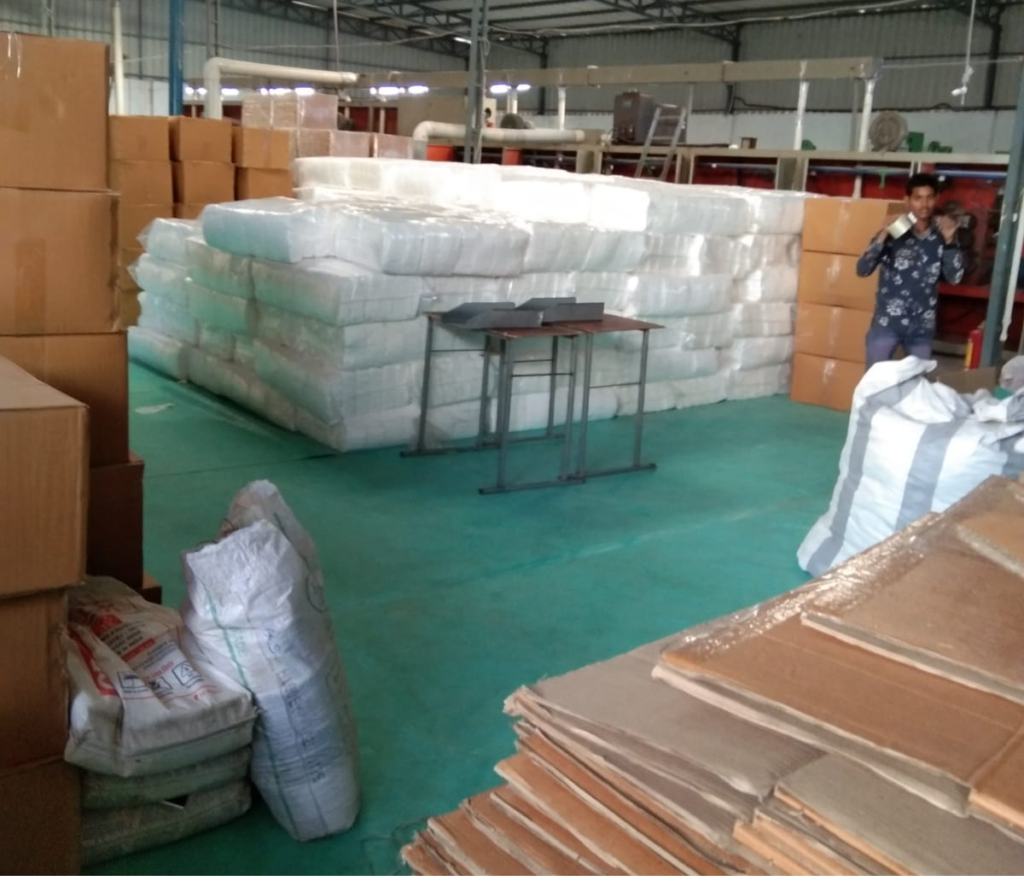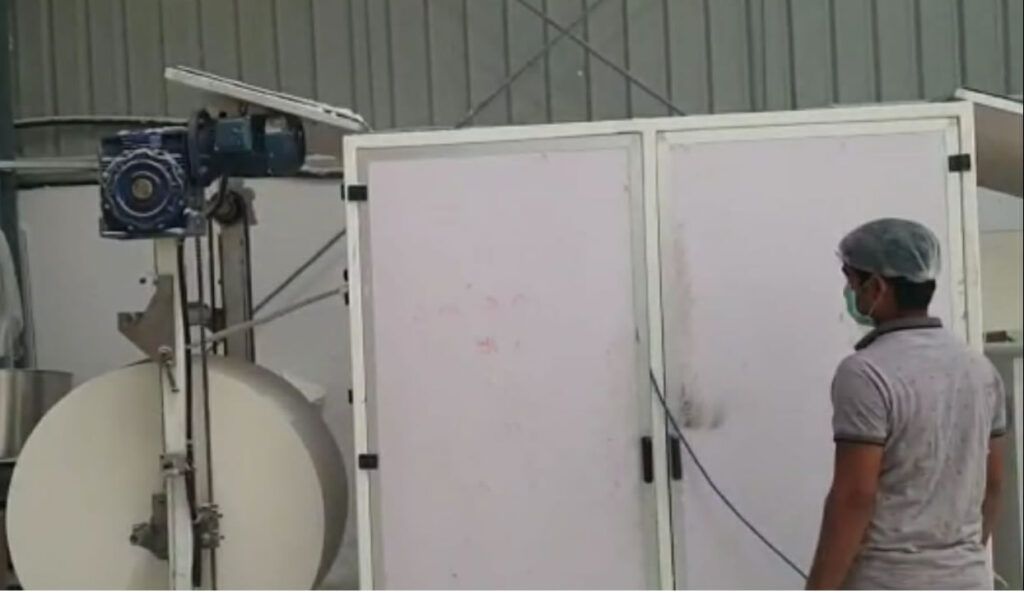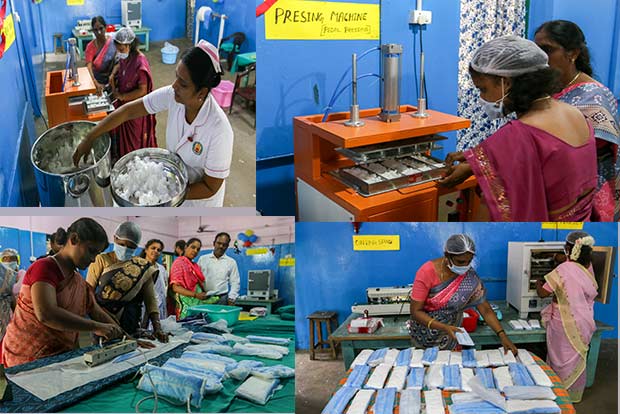SMB Women Care pvt.Ltd is a group company, focusing on the field of health care products, integrating research & development, design, production and trading in one. We have factories in many metro cities across the country.Our production capacity, equipment level, quality of functional design are all up to international level. The factories use the most technically advanced production machines in the world, and are equipped with clean, dust-proof, hygienic workshops and 42 auto speedy production lines.
SMB has always insisted on creating “The Most Market Value” quality products and services for customers. We develop custom solutions with market benefits according to the product conception, raw materials, product structure optimization, product function, product appearance and environmental ecological sustainability, etc.
We have been……
developing superior raw materials with our raw material suppliers,
developing new manufacturing technique with our machine suppliers,
innovating/introducing new substitute materials & designs to save cost,
innovating unique products with our customers to meet their local market.
(i) fluid acquisition layer
(ii) distribution component
(iii) absorbent structure
(iv) liquid impervious membrane.
(i) Fluid acquisition layer: A lot of R&D has been done to keep the top surface dry so that it does not cling to the body and fits comfortably. This layer is a perforated film which allows liquid to pass through it quickly into the absorbent structure and stays dry, since the fluid is entrapped in the structure. It thus reduces the chance of leakage.
(ii) Distribution component: This component spreads out the fluid, especially in the longitudinal direction, for better utilisation of the product. By spreading fluid, it increases the probability of more retention of fluid.
(iii) Absorbent structure: One of the main characteristics of sanitary pads is to absorb body fluid and retain it for a long period of time and avoid back flow under pressure.
(iv) Liquid impervious membrane: This is the last layer. It acts as a barrier to prevent fluid from leaking.
Liquid flow through the interface among these three components (top layer, absorbent layer and barrier film) and mainly within the absorbent component is the key factor in deciding the performance of a sanitary napkin. To understand the working principle of sanitary napkins we have to consider the flow path of fluid through each layer of a sanitary pad.
Barrier layerAs fluid comes vertically in contact with the first layer, it moves across the fluid acquisition layer to the absorbent layer without spreading in the facing layer. Once fluid reaches the absorbent layer, it spreads and can be held without reversing flow direction.
The first problem in sanitary pads is the interface between acquisition layer and absorbent layer. The acquisition layer is mainly made up of hydrophobic fibre and the absorbent layer is composed of hydrophilic fibre so the fluid must get readily transferred from acquisition layer to absorbing medium. Transfer of fluid from one layer to other will fail if there is not enough intimate contact between the two layers. Any gap will alter the pattern of flow and liquid may spill and lead to failure of the product.
Almost all sanitary pads use fluffed cellulosic pulp as the core component of the absorbent material. This fluff is prepared by defibrillation of unopened compressed cellulosic boards. There is always a chance of some amount of unopened board which gives heterogeneity to the absorbent material. Therefore, uneven flow and retention of fluid will be different from the rest of the area.
Performance of sanitary pads can be evaluated on fluid retention capacity or the amount of fluid sustained after applying pressure. One factor which affects fluid retention is density. Modern commercial sanitary pads are made from super absorbent fibre used in compressed and uncompressed form. Density significantly influences the absorption and stability of the product. A highly compressed fibre will expand on absorption whereas in case of lightly compressed fibre, it will collapse as a result of absorption. So compression of absorbent material is necessary to maintain its structural integrity.
The top layer is designed to transfer fluid from the top cover to the immediate secondary layer. An efficient sanitary pad should be dry for comfort. Traditional sanitary pads were of multilayer cellulosic material. Instead of dripping down, fluid tended to remain at or near the surface. This led to discomfort so one proposed solution has been to use thermoplastic fibre. It has been found that at least 20 per cent of the fibre should be hydrophilic to provide sufficient capillary attraction to pull the fluid through the cover and provide a dry surface.
(ii) Acquisition and distributing layer:
As absorbent core cannot absorb fluid immediately, so this layer imbibes the fluid, drawing it away from the point of discharge, distributes it laterally and holds it for the core to absorb. It is generally made up of thermally bonded or air bonded composite non-woven.
(iii) Absorbent layer:The absorbent core of the sanitary pad is generally made up of cellulosic pulp but there have been some changes in the composition. Nowadays, SAP is air laid with pulp and used to increase absorbency. The position of this polymer is important as it may clog the pore of the structure and restrict absorption of fluid, so the SAP polymer is affixed to a tissue and placed between the pulp and back sheet.
(iv) Barrier sheet: The back sheet is a fluid impermeable sheet which prevents leakage, generally made up of polyethylene.
6.1 Absorbency test:
This method determines the total absorption capacity of the material. According to the test standard ISO 5405-1980, a sample is laid on a flat level and transparent surface, so that the underside of pad can be observed. Fluid is to be dripped, at the rate of 15ml per minute, so that 30 ml of the fluid maintained at a temperature of 2702C is poured on to the centre of the sanitary pad from a height of approx. 1 to 2 mm. After the napkin has absorbed the full amount of fluid, the standard weight of 1 kg is put above the sample for a minute on the portion where the fluid is absorbed. After that the back and sides of the pad are observed for fluid flowing up. The reading is recorded.
6.2 Fluid Retention capacity:
The measurement of fluid retention is determined by using the standard ASTM D 461. A sample of the pad is to be immersed in fluid at room temperature for five minutes to completely wet it out. The fluid \-logged sanitary napkin is weighted, dried and reweighed. Fluid retention is calculated as a percentage of dry mass.
6.3 Liquid strike through test:
A drop of test solution is allowed to fall on the sample and the time taken for the solution to transport from the upper layer of the napkin to the inner layers of the sample. This is measured by observing the drop closely so that the dull wet spot is seen on the wet area of the sample. All samples should be conditioned for 24 hours before the tests.
SMB adheres to “Quality First, Credit First” service purpose to sincerely provide customers competitive products and humanized services. We have established a mature quality control and management system, including a clear traceability system.
For traceability, parts and products can be identified individually or by batch, and information is accumulated during each process, including tracking product movement and tracking records back on the timeline. If there is any quality problem, we will 100% take responsibility for it.
Quality Certificates
BINGBING has the mature quality control and management system. All products are carried out with the standards of FDA, GOTS, CE, ISO9001, SGS, ITS, FSC, MSDS, etc.






